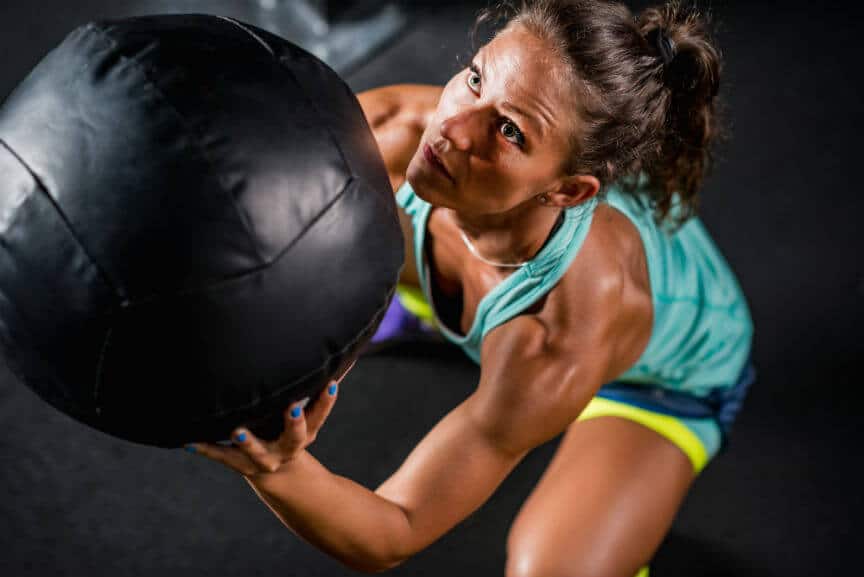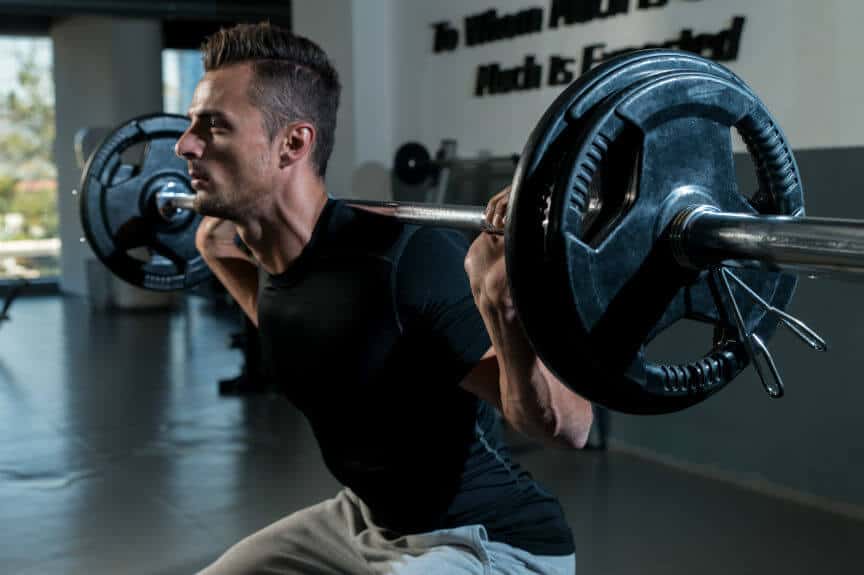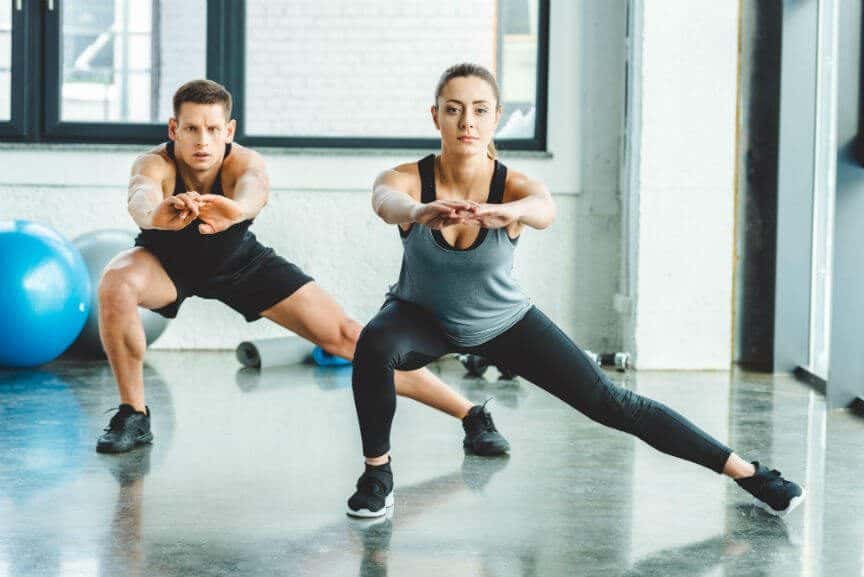Playing tennis is in and of itself a great workout. Many players today, however, want to increase their conditioning by working out in the gym or doing additional training off the court.
This can be a great way to supplement your tennis workouts. The extra conditioning can give you an added boost in terms of strength and stamina. This combined with tennis drills can help improve your game.
The list of exercises below are by no means the only exercises available to you, however, they represent a list of exercises that I have used myself and that I have found to be most effective.
Every person is different and training for different reasons. Each person also reacts differently to exercise, some may need more strength training, while others may need more aerobic conditioning.
Dynamic Warm Up
When you begin any exercise routine, it’s a good idea to start out slow and warm up little by little. Dynamic warm-ups are a great way to do this. You can start out by jogging slowly.
If you have limited space to work with, simply jog in place for about 5 minutes or so. Other options, if available, include the elliptical machine, indoor cycle, or the treadmill.
Basically, anything that will allow your muscles to warm up and get your heart rate up slowly can work. Just be sure not to start out too intensely, the idea is to work your way into it slowly.
Stretching
Stretching is something that is oftentimes overlooked, but it’s important to do in order to avoid potential injury. Be sure to stretch out both your upper body and lower body following the dynamic warm-up.
Just as important as it is to stretch before exercising, it’s also just as important to do so after your workout. Doing so will prevent you from being sore and help prepare you for your next workout to follow.
Below are a few examples of stretches you can do to prepare for your workout. Just be sure to engage all the muscles that you will be training. Don’t just stretch your legs, for example, and neglect your upper body.
Standing Hamstring Stretch
- Stand with your feet about hip-width apart, knees slightly bent, and arms to the side.
- Bend forward, lowering your head towards the floor, and grab the back of your legs.
- Hold this position for about a minute.
Standing Side Stretch
- Stand with your feet together and straighten your arms above your head with your hands clasped together.
- Lean towards one side until you feel the stretch.
- Take five breaths and then reverse to the other side.
Lunge and Spinal Twist
- Take a step forward with your knee bent and go into a lunge position.
- Place the hand opposite to the lunging leg on the floor.
- Rotate around your torso so that the other hand is pointing to the sky.
- Hold for about 30 seconds and repeat on the opposite side.
Seated Back Twist
- Sit down on the floor with your legs in front.
- Keep one leg straight and bend the other leg so the knee is about chest height.
- Bring the bent leg around the straight leg. The foot should touch the outside of the knee of the straight leg.
- Place your elbow opposite the bent leg and twist around your torso until you feel a stretch.
- Hold for 30 seconds and repeat on the opposite side.
Triceps Stretch
- You can perform this stretch either standing or kneeling.
- Bring one arm around the back of your head and touch the top of your back.
- Gently press down with the other hand on the bent elbow until you feel a stretch.
- Hold for about 30 seconds and repeat on the opposite side.
Side Arm Rotations
- Stand while extending your arms out at shoulder level towards your sides and parallel to the ground.
- Rotate your arms in a small circular motion, first forward for about 30 seconds, and then backward for about 30 seconds.
- The motion should be slow and controlled with the fingers of your hands pointing towards the sides.
Hanging Back Stretches
- Grasp onto an overhead bar and allow the weight of your body to gently stretch your arms and back.
- The stretch can be done with both hands grasping the bar simultaneously, or one arm at a time.
Butterfly Stretch
- Sit on the floor with your knees to your sides and soles of your feet together in front of you.
- Move your head forward and grasp your ankles in front of you until you feel the stretch.
- Press down gently on your knees with your elbows. Hold for about 30 seconds.
Hip Flexor Stretch
- Kneel on one leg and step forward with the other leg with your knee bent.
- Lean your head and upper body forward until you feel a stretch.
- Hold for about 30 seconds and repeat on the opposite side.
Knee to Chest Stretch
- Lie on the floor with your legs resting on the ground.
- Bring one of your legs up to your chest, grasping your knee with both hands.
- Hold for about 30 seconds and repeat doing the same with the other leg.
Quad Stretch
- You can perform this stretch either by standing or lying on your side.
- Bring one leg up to your glutes by grasping your foot with your hand, while keeping the other leg straight.
- Hold for about 30 seconds and repeat on the other side.
Upper Body Exercises

The upper body exercises that follow focus on the muscles that are used in tennis. Strength training for tennis differs from traditional strength training in that the goal is to develop power and agility while at the same time preventing injury.
Strengthening the muscles around your joints, particularly the shoulders, for example, can play a big role in preventing injuries. Many of the exercises below focus on the shoulders for this reason.
Additionally, you will notice that the number of reps is on the high side when compared to traditional lifting. The goal is not necessarily to build up muscle mass, but rather to increase strength and endurance.
You should perform these exercises with adequate weight to challenge yourself, but heavy lifting should not be your goal. Quick, but controlled movement and high repetition should be your aim when performing the exercises.
1. Dumbbell Y Raises
- Stand with your feet at least shoulder-width apart and lean forward slightly, keeping your knees slightly bent.
- With a lightweight dumbbell in each hand, starting at about hip level in front of you, raise your arms in a diagonal vee direction.
- Keep your arms straight and palms facing one another during the full exercise.
- Lower the arms down in a reverse vee direction and bring the dumbbells back to the starting position.
- Repeat the motion about 20-25 times.
2. Side Arm Raises
- Stand with your feet at least shoulder-width apart and lean forward slightly, keeping your knees slightly bent.
- With a lightweight dumbbell in each hand, held on your sides at hip level, raise your arms up to about chest height.
- The palms of your hands should be facing the ground. Be sure to keep your elbows bent and tucked to your sides during the motion.
- Bring the dumbbells back down to the starting position and repeat the motion 20-25 times.
3. Dumbbell Scarecrows
- Stand with your feet at least shoulder-width apart and lean forward slightly, keeping your knees slightly bent.
- With a lightweight dumbbell in each hand, held at shoulder level, elbows to your sides, raise the weights back towards your ears, maintaining a 90-degree bend in your elbows.
- Lead with the back of your hands. The palms of your hands should start parallel to the ground and end up perpendicular to the ground once at ear level.
- Bring the dumbbells back to the starting position maintaining the 90-degree elbow bend. Repeat about 20-25 times.
4. Dumbbell Coke Pours
- Stand with your feet at least shoulder-width apart and lean forward slightly, keeping your knees slightly bent.
- With a lightweight dumbbell in each hand, starting at about waist level in front of you, raise the dumbbells, thumbs pointing up, to about chest height.
- Lower the dumbbells to the starting position and then rotate your hands so that your thumbs now point down as if you are pouring coke out of a can.
- Again, raise your arms up to about chest height, pause, and lower them again to the starting position.
- Your palms start facing each other in the first sequence and then reverse so they are pointing away during the second sequence.
- Repeat the two sequences about 20-25 times each.
5. Elbow Push-Ups
- Start out similarly as you would if you were doing a regular push-up, facing down, legs straight, and on the tips of your feet.
- However, rather than resting and pushing up with your hands, rest your elbows on the ground.
- From here, perform the push-up as you normally would, using your elbows to raise and lower your body.
- Be sure to keep your body straight. If you find the exercise too difficult, you can put your weight on your knees to perform the movement.
- Try to do as many as you can until it starts to become difficult to complete the push-up.
6. Medicine Ball Overhead Toss & Catch
- Stand with your feet a bit more than should width apart.
- Hold the medicine ball in front of you at about waist height.
- Bend your knees as if you are squatting, and then explode upwards, tossing the medicine ball up in the air.
- Catch the medicine ball overhead as it comes back down, and return to the starting position.
- Repeat the motion 20-25 times.
7. Split-Stance Scoop Throw
- Stand about 5 feet, body parallel to a wall, holding a medicine ball with both hands at about waist level.
- Rotate the ball back to one side, past your hip, then forcefully throw it forward against the wall and catch it on the rebound.
- Repeat the motion a few times and then on the opposite side after you catch the ball.
- Repeat the sequence about 20-25 times or until exhausted.
8. Medicine Ball Slams
- Start with a medicine ball held with both hands above your head and knees slightly bent.
- Forcefully slam the ball on the ground slightly in front and directly below while maintaining your feet about hip-width apart.
- Be sure to slam the ball down methodically, there is no need to rush the exercise.
- Repeat the motion about 20-25 times or until exhausted.
9. Bench Press
- Lie on a bench with your back slightly arched and hold a barbell or dumbbells overhead.
- Bring the dumbbells or barbell down to about chest level and press the weights back up to the starting point.
- As an alternative, you can do regular push-ups in place of the bench press.
10. Pull-Ups
- Start suspended with your feet off the ground, clasping an overhead bar with both hands.
- Lift yourself up so that your chin passes above the bar, keeping your knees bent and feet crossed behind you.
- Drop back down to the starting position and repeat as many times as you can, up to 25 repetitions.
- If regular pull-ups are too difficult to perform, you can use a weight-assisted pull-up machine or pull-up assist band. Alternatively, you can use a lat pulldown machine.
11. Dumbbell Tricep Extensions
- Hold a dumbbell behind your head with your elbow bent in front of you.
- With the opposite arm, hold your elbow in place for support and lift the dumbbell up toward the ceiling.
- Bring the weight back down to the starting position and repeat 20-25 times. Repeat with your other arm.
12. Rope Swing
- Stand with your legs more than shoulder-width apart, leaning forward with your knees slightly bent.
- Hold two heavy exercise ropes in front of you at about hip height and move your arms up and down in alternating fashion while holding the ropes.
- Continue to move the ropes up and down with your arms, creating a wave-like pattern in the ropes. Keep going until exhausted.
Lower Body Exercises

When playing tennis, you will be using your legs a lot. This is the reason you want to strengthen them, but at the same time, you want to remain agile and be able to move explosively. Therefore, avoid heavy weights.
Similar to the upper body exercises, your focus for the lower body should be on higher repetition and lighter weight. Movement for many of these exercises should be explosive to simulate activity on the court.
Choose a weight that is challenging for you, but allows you to complete the number of repetitions without causing too much strain on your legs and joints. This will help prevent injury when transitioning to the court.
13. Barbell Squats
- Stand with your feet at least shoulder-width apart while holding a weighted barbell on your shoulders and on the back of your neck.
- Support each end with your arms for balance, extending your arms out to grasp the bar.
- Squat down lowering your glutes to about knee level, and then rise back up again to the starting position.
- Be sure to keep your back straight and your head looking forward (never down) during the motion. Push up with your legs.
- If you find the barbell is too difficult to perform, you can use dumbbells, holding them on your sides as you squat up and down.
14. Weighted Lunges
- Hold a dumbbell in each hand, about hip level on each side of the body.
- Step forward and bend your knee with one leg while keeping the back leg straight.
- Hold for a few seconds and then push yourself back up to a standing position with your front leg.
- Repeat the same motion alternating with your other leg in front. Do 20-25 reps on each leg.
- You can increase the intensity by placing your back foot on a bench. This will also work on your balance.
15. Skier Lunges
- Stand with your feet at least shoulder-width apart, leaning forward, with your arms in front of you.
- Push off with one leg to the other side and land on the opposite leg bringing the leg you pushed off with around the back.
- Reverse the motion now pushing off the opposite leg and continue to go back and forth a total of 20-25 times.
- Try to get low on the ground and keep your knees bent. If you need to, tap the foot of the back leg on each lunge for support.
16. 3-Point Lunges
- Stand with your feet hip-width apart and lunge to the front, bending your knees as you step forward.
- Come back to the starting position and now lunge to the side, bending your knee and keeping the pivot leg straight.
- Return to the starting position again and now lunge backward, bending your knees as you go back.
17. Box Jumps
- Place an aerobic platform in front of you and stand in front of it with your feet about shoulder-width apart and knees bent.
- Jump onto the platform and land with both feet on the platform, bending your knees after landing.
- Once fully balanced, jump backward and land on both feet on the floor, bending your knees as you land.
- Continue this sequence for about 20-25 repetitions or until you begin to feel a good burn in the legs.
18. Plyometric Squat & Jump
- Stand with your feet at least shoulder-width apart, knees bent, arms in front, and body leaning forward.
- Lower your body into a squat position, bending your knees, and then burst up in the air as high as you can.
- Land on both feet and keep your knees bent on the landing. Repeat the squat and jump about 20-25 times.
- For added variation, you can rotate your body slightly as you jump so that you land 45 degrees to the right, forward, and 45 degrees to the left.
19. One Leg Balancing
- Place your arms on your hips with your feet about hip-width apart.
- Stand on one leg, bringing the other up a bit with your knee bent. Your foot should be resting on the side of your leg.
- Hold this position for about 30 seconds and then switch to the opposite leg and repeat.
- To make the exercise more challenging, you can use a BOSU ball.
- If you find it difficult to balance yourself, support yourself with a horizontal bar or vertical post.
20. Weighted Tip Toe Walk
- Hold a dumbbell or plate weight in each hand, at your sides about hip level, and stand on the balls of your feet.
- Next, walk forward holding the weights at your sides and stepping on the balls of your feet as you walk.
- Walk a few feet forward, pivot around, and then reverse back to the starting point.
- Walk slowly in a controlled fashion, remaining on the balls of your feet as you walk.
- Repeat the sequence about 20-25 times, or until your legs begin to feel exhausted.
21. Romanian Dead Lifts
- Place a weighted barbell in front of you on the floor and stand with your feet at least shoulder-width apart.
- Bend your knees, lower your body, and place your hands on the barbell, greater than shoulder-width apart.
- Raise the barbell up to about hip height, making sure to use your legs to lift the weight up.
- Lower the weight down to just below your knees, hinging from your hips and keeping your legs straight.
- Bring the weighted bar back up to about hip height and repeat the motion about 12-15 times.
22. Back Extensions
- Set up on a hyperextension bench with your ankles secured in place and arms crossed in front across your chest.
- Slowly lower your upper body, pivoting about your hips and keeping your upper body straight.
- Once at the low position, slowly raise your upper body back up the starting point.
- Be sure to keep your back straight, never rounded or arched, as you perform the movement and do not overextend at the top.
- Repeat 20-25 times or until you begin to feel the exercise becoming more difficult to perform.
23. Stomach Crunches
- Lie on your back with your knees bent and place your hands to the side of your head or across your chest.
- Bring your shoulder blades off the floor in a controlled manner and hold for 1-2 seconds.
- Bring your shoulder blades back down so that they end up in the starting position.
- Repeat the motion about 50 times or until you reach the maximum number you are able to do.
24. Side Crunches
- Lie on your side with both knees bent. Extend the bottom arm (on the floor) forward for support.
- Use the top arm to support your head and bend up to perform a crunch. Bring your legs up off the floor at the same time.
- Hold at the top for 1-2 seconds and come back down again to the starting point.
- Repeat the motion 25-30 times and then turn on the opposite side and repeat the exercise.
25. Leg Raises
- Lie flat on your back with your legs in front of you. Lift your legs off the floor and bring them up until perpendicular to the ground.
- Hold at the top for 1-2 seconds, then slowly and in a controlled manner lower your legs back down, keeping them straight as you come down.
- Repeat the motion 25-30 times or until you begin to tire out.
- If you want to make the exercise more challenging, you can increase the intensity by doing hanging leg raises, suspended from a bar.
On-Court Drills
In addition to strength exercises, there are many drills you can do on the court to improve your conditioning and movement skills. When used in combination with strength training, on-court drills can yield good results.
Be sure to check out the article on tennis drills for ideas. It outlines 20 drills that can help improve your game, from footwork drills to court movement, ball placement, and stroke development.
Closing Notes
Strength training, when combined with on-court training, can be very beneficial to your game. While it will add additional time and commitment to your tennis training, the benefits are worth it.
Ideally, you should be performing these exercises about 4 days out of the week. Two days focused on the upper body exercises, and two days focused on the lower body exercises. If you are able to combine the upper body and lower body exercises in a single workout, then aim for three days a week.
Over time, the combination of tennis workouts with on-court training will begin to pay off if you are consistent. Remember that results do not come about overnight, but rather little by little in incremental steps.
Be consistent in your training, always pushing yourself to become better and to train harder. Each day you devote to training is another building block towards your goal of becoming a better player.

